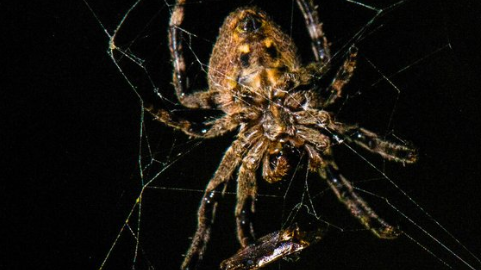“Spiders like the Portia are a testament to the intricate dance of evolution, where intelligence isn’t just a human trait but a widespread survival tool across species.” — Arachnologist, Robert Jackson
“The bolas spider’s approach to hunting is like something out of a spy novel—silent, calculated, and almost poetic in its precision.” — Entomologist, William Eberhard
In a surprising twist of nature, a common orb-weaving spider in East Asia, Araneus ventricosus, has been found to manipulate male fireflies into sending out deceptive signals, attracting even more fireflies into its deadly web. This behavior, which seems straight out of a science fiction story, reveals the spider’s cunning strategy for increasing its catch.
Researchers have observed that once a male firefly gets trapped in the spider’s web, it begins to emit light signals that are typically used by female fireflies to attract mates. These signals, instead of serving as distress calls, actually lure other unsuspecting male fireflies into the web, turning the trapped insect into a tool for its own demise and the spider’s benefit.
If you’re a lonely male firefly looking for love, watch out—that alluring female flashing in the distance might be the work of a spider puppet master trying make you her next meal! I wrote about this tangled web of deception for the NYT, check it out!🕷️ https://t.co/jnkYRcUgTV
— darren incorvaia (@MegaDarren) August 20, 2024
The scientists first noticed this peculiar behavior when they found an unusually high number of male fireflies caught in the spider’s webs. This pattern was consistent across multiple field studies, suggesting that something more than chance was at play. Upon closer observation, they discovered that the trapped fireflies were flashing in a way that mimicked the mating signals of female fireflies, a behavior that is highly unusual for males.
To test their findings, the researchers conducted a series of experiments, observing how other fireflies responded to the webs with and without trapped fireflies. The results were striking: webs with a trapped firefly that was flashing like a female had a significantly higher catch rate. This finding led the researchers to conclude that the spiders are somehow causing the male fireflies to send out these misleading signals.
The exact mechanism behind this manipulation is still a mystery. However, the researchers observed that the spider employs a specific attack method when dealing with flashing fireflies. It uses a repeated wrap-and-bite tactic, which seems to trigger the altered signaling in the trapped fireflies. Interestingly, this attack only occurs when the firefly’s lights are visible; when the lanterns are covered, the spider does not perform the same attack, indicating that the visual cue of the flashing might be integral to the manipulation process.
Incredible
Scientists discover a spider that alters bioluminescent flash of captured male fireflies to appear to be a female firefly in order to trick more female-seeking males into flying into its web https://t.co/BHrbPN4DpK pic.twitter.com/HZ7sG9FQrq
— Chris Nagano (@charliesaito22) August 20, 2024
This behavior highlights an intricate and previously unknown level of predation in the natural world, where spiders are not just passive hunters but active manipulators of their prey’s behavior. The ability to puppeteer a living creature into attracting more prey demonstrates a sophisticated strategy that is both fascinating and chilling.
In nature, this kind of manipulation isn’t entirely new. Other spiders have been known to use decoys, like building fake spiders out of debris to confuse predators. However, using a living, flashing firefly as bait elevates this tactic to a new level of predatory ingenuity.
More on Spiders…
- “If ever there were a master of disguise and strategy in the spider world, it would be the Portia. This tiny creature plots its attack with the cunning of a chess grandmaster.” — Unknown Naturalist
- “Spiders like the Portia are a testament to the intricate dance of evolution, where intelligence isn’t just a human trait but a widespread survival tool across species.” — Arachnologist, Robert Jackson
- Portia Spiders (Portia spp.): Perhaps the most famous for their cunning, Portia spiders are known as the “brainiest” spiders. They use trial and error to solve complex problems, adapting their strategies based on the situation. They can mimic the vibrations of prey caught in webs, luring the actual web owner into a trap.
- Spitting Spiders (Scytodes spp.): These spiders immobilize prey by spitting a sticky, venomous silk from a distance. This strategy allows them to capture prey without having to engage in a direct fight.
- Net-casting Spiders (Deinopis spp.): Also known as ogre-faced spiders, they create a small, rectangular web that they throw over unsuspecting prey. They have incredible night vision, allowing them to hunt effectively in the dark.
- Bolas Spiders (Mastophora spp.): These spiders use a “bolas,” a sticky glob attached to a silk thread, which they swing to capture moths. Fascinatingly, they release chemicals that mimic the scent of female moths, luring male moths close enough to be snagged.
Key Points:
i. Araneus ventricosus, a common orb-weaving spider, manipulates trapped male fireflies to emit signals that attract more prey.
ii. The spider’s webs consistently catch more male fireflies due to these deceptive signals.
iii. manipulation seems to be triggered by the spider’s specific wrap-and-bite attack on the flashing fireflies.
iv. This predatory behavior is unprecedented in its complexity and highlights the spider’s active role in altering prey behavior.
v. The discovery adds to our understanding of the intricate and sometimes sinister strategies employed by predators in nature.
Kirk Volo – Reprinted with permission of Whatfinger News



